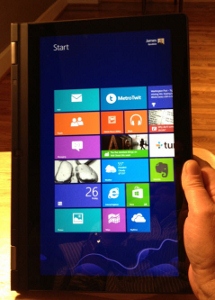Hands on with Windows 8 on a hybrid: Symbian on the desktop


Microsoft has shaken up the PC world with Windows 8 by producing an OS that tries to straddle both the desktop and the mobile space. It is trying to do too much and not delivering enough for this user. The more I use Windows 8 on a new hybrid PC the more it reminds me of the Symbian platform for smartphones.
I have spent many hours using full Windows 8 on the innovative Lenovo Yoga 13 hybrid computer. That time has been divided equally using the hybrid as a laptop and a tablet, since that is the future Microsoft sees for us. In building Windows 8 to deliver the two radically different user scenarios presented by tablets and laptops, the new OS fails to deliver a good user experience in either one for this writer.
The largest failing of Windows 8 for tablet devices is the total lack of intuitive operation. For a tablet to deliver a compelling user experience, the OS driving it must be simple to operate without a lot of practice. You need to pick up the tablet and start doing things in an obvious way.
Windows 8 fails in this horribly. Controls needed to perform common tasks are not obvious in their functions when spotted, and worse some are totally hidden from view. You must know they are there and how to swipe in from off the display to engage these controls when using a touch tablet.
As I logged hours on the hybrid with Windows 8, it struck me that the user experience was much like that on Symbian phones.
In my many years of using mobile devices, hidden controls that are seldom used are bad enough, but common controls that can't be seen on every screen are deplorable. If using a mobile device requires learning basic operation, and then practicing said operation, then this is a major failure of UI design. That is the antithesis of intuitive operation, vital for devices used by touch.
Inexplicably, Microsoft has chosen to make these common touch controls work in a totally different way for devices with a trackpad/mouse. The hidden controls operated by swiping from the sides of the screen by touch are accessed by moving the cursor to the corners of the display. Again, you have to just know the controls are there and then move the cursor all the way to the corners to activate them.
These two methods of control, neither of which is intuitive by design, are exacerbated on the very hybrid devices that Microsoft is pushing hard (think Surface) for Windows 8. You not only have to learn and practice one set of bizarre controls, you must do it twice for use on hybrids in both tablet and laptop arrangements.
As I logged hours on the hybrid with Windows 8, it struck me that the user experience was much like that on Symbian phones. The Symbian OS started as a simple platform for cell phones, but evolved into a sophisticated OS for smartphones.
The oft-maligned Symbian was surprisingly powerful and sophisticated, but what plagued the platform was the lack of intuitiveness in operating phones running the OS. Symbian was designed to be run on phones via simple buttons, and as it grew in functionality it became hard to learn and hard to operate for new users.
This is exactly what plagues Windows 8 in my opinion. Sure it is easy to operate once you learn it inside and out, but that's the very definition of something that is not intuitive by design.
Like the hundreds of millions of Symbian enthusiasts over the years, no doubt Windows 8 will have it's horde of happy users. Like Symbian before it, however, that doesn't mean Windows 8 is a great platform for all of the user scenarios Microsoft is pitching.